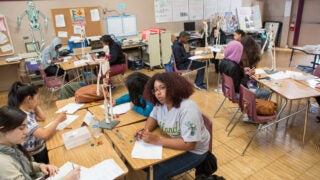USC engineering students soar with Mars transport design
Annual event focusing on long-distance space travel attracts teams from dozens of universities
USC Viterbi School of Engineering students won first place in the graduate division of an annual competition among U.S. universities to design a Mars transport for NASA space travel.
As part of the competition, students design and analyze spacecraft and architectures that will yield long-distance space travel. This year, students had a choice of four themes of space exploration.
The USC Viterbi team chose the theme “Artificial Gravity Reusable Crewed Deep Space Transport.” The team’s mission: Design a spaceship with an artificial gravity similar to Mars that can last for three missions to and from Earth over a span of 15 years.
While the reason to simulate the gravity of Mars was unspecified, team leader Gedi Minster suggested that its purpose is to get astronauts acclimated to the conditions on Mars before stepping on the red planet.
The concern is that astronauts, after spending six months in interplanetary space, are going to land on Mars and they won’t be able to function effectively.
Gedi Minster
“The concern is that astronauts, after spending six months in interplanetary space, are going to land on Mars and they won’t be able to function effectively,” he said. “That’s why we are creating artificial gravity — to get them ready during their long journey.”
Mars transport and zero gravity
When astronauts return to Earth — after living in a zero-gravity environment aboard the International Space Station — it’s difficult for them to move around and they must readjust their sense of orientation and balance. It can take weeks before they are able to function normally.
To simulate gravity, the team, advised by Research Professor David Barnhart, director of the Space Engineering Research Center at USC’s Information Sciences Institute, designed a spinning spaceship called Hyperion. The rotation creates a pulling sensation toward the floor of the spacecraft that mimics the effects of gravity. In this case, the team calculated that its spacecraft would need to spin at the rate of about three rotations per minute to simulate the gravity of Mars, which is roughly 38 percent that of Earth’s.
This method of creating artificial gravity is widely used in sci-fi movies and is currently the most technologically feasible option.
“But exactly what you spin is one of the big design choices,” Minster explained.
The USC Viterbi team was the only one in the competition to choose to spin the entire spaceship. This allowed them to avoid the tricky connectivity issues between rotating and stationary modules.
To ensure the success of their project, the engineers — consisting of both graduate and undergraduate students from the Department of Astronautical Engineering and the Department of Aerospace and Mechanical Engineering — worked with reviewers from NASA’s Jet Propulsion Laboratory and scientists from ESA’s ExoMars team. They also collaborated with students from the USC School of Architecture to design their poster and the USC School of Cinematic Arts to create a video directed and edited by Jono Seneff.
The team plans to present its work at the International Astronautical Conference this fall.



